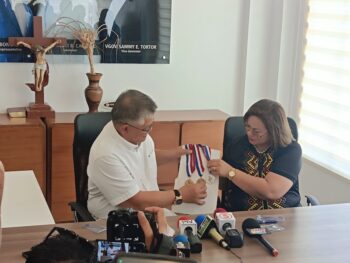TACURONG CITY, Sultan Kudarat (MindaNews/11 Nov) — In an almost two hectares of land lying by a river bank, the crack of dawn offers an orchestra belted by an opera house of birds at their majestic humming and chirping glory.
Thousands of them also dot the sky during sunsets, a pleasure for bird watchers.
Welcome to the Baras Bird Sanctuary, a piece of land previously planted with black pepper owned by Rey Oliver Malana.
 It is home to more than 10,000 bird species, mainly the nocturnal Black Crowned Night Heron (Nycticorax) and cattle egret. The former is believed to have originated from Japan and the latter, which locals called tulabong, is endemic, white and commonly seen in rice fields.
It is home to more than 10,000 bird species, mainly the nocturnal Black Crowned Night Heron (Nycticorax) and cattle egret. The former is believed to have originated from Japan and the latter, which locals called tulabong, is endemic, white and commonly seen in rice fields.
Losing the black pepper plantation — even if it’s sufficiently earning — to the birds was more of a blessing than a curse.
“You cannot compare our bird sanctuary to the rest of the bird sanctuaries in the Philippines. The night herons, from being a migratory bird, have made our place their permanent residence,” Malana said.
The former seaman, who has seen exotic birds in other countries at dock breaks, first noticed in 1996 four night herons in the then thriving black pepper plantation.
Since then the birds kept on returning with new species, their population rapidly multiplying as they have been hatching eggs and building nests at the farm.
Other birds that can be seen in the sanctuary include the intermediate egret, great egret and rufus night heron.
A visit to the sanctuary offers not much hassle; it is accessible even by car in a dirt road dotted by oil palm trees.
The site is just several kilometers off the national highway in this city, where cheap hotels are available.
The city government declared Baras a bird sanctuary on Aug. 7, 2002.
It’s beautiful here before the crack of dawn, with the soul listening to the hum of the birds, while nearby the river gushes amid dancing bamboo leaves flirting with the wind.
The birds hunt for food, particularly fishes, in nearby Liguasan Marsh, Lake Buluan and Lake Sebu. Liguasan and Lake Buluan straddle part of North Cotabato, Maguindanao and Sultan Kudarat while Lake Sebu is in South Cotabato. The birds were also monitored as hunting food in the remote coastal town of Lebak in Sultan Kudarat.
They leave around 5:30 in the afternoon and come back at 4:30 in the morning.
The birds’ breeding season peaks from February to March but they never stop laying eggs all year round. A night heron’s egg is slightly bigger than a ping-pong ball. A fully grown bird could weigh to about a kilo.
Malana noted that the bird sanctuary impressed representatives of Haribon Foundation, an environmental group, which described Baras Bird Sanctuary as “compared to nothing like in the Philippines.” (Bong S. Sarmiento / MindaNews)
